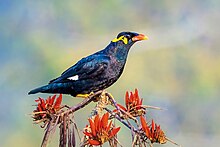Common hill myna
| Common hill myna | |
|---|---|

| |
| G. religiosa at Satchari National Park, Habiganj District, Bangladesh | |
| Scientific classification | |
| Domain: | Eukaryota |
| Kingdom: | Animalia |
| Phylum: | Chordata |
| Class: | Aves |
| Order: | Passeriformes |
| Family: | Sturnidae |
| Genus: | Gracula |
| Species: | G. religiosa
|
| Binomial name | |
| Gracula religiosa | |

| |
| Distribution of various forms within the species complex | |
| Synonyms | |
|
Gracula indica (but see text) | |
The common hill myna (Gracula religiosa), sometimes spelled "mynah" and formerly simply known as the hill myna or myna bird, is the
The common hill myna is a popular talking bird. Its specific name religiosa may allude to the practice of teaching mynas to repeat prayers.[3]
Description
This is a stocky jet-black myna, with bright orange-yellow patches of naked skin and fleshy wattles on the side of its head and nape. At about 29 cm length, it is somewhat larger than the common myna (Acridotheres tristis).[4]
It is overall green-glossed black plumage, purple-tinged on the head and neck. Its large, white wing patches are obvious in flight, but mostly covered when the bird is sitting. The bill and strong legs are bright yellow, and there are yellow wattles on the nape and under the eye. These differ conspicuously in shape from the naked eye-patch of the common myna and bank myna (A. ginginianus), and more subtly vary between the different hill mynas from South Asia: in the common hill myna, they extend from the eye to the nape, where they join, while the Sri Lanka hill myna has a single wattle across the nape and extending a bit towards the eyes. In the southern hill myna, the wattles are separate and curve towards the top of the head. The Nias and Enggano hill mynas differ in details of the facial wattles, and size, particularly that of the bill.[4]
Sexes are similar; juveniles have a duller bill.[4]
With the southern, Nias and Enggano hill mynas as separate species, the common hill myna, Gracula religiosa, has seven subspecies, which differ only slightly. In taxonomic order, they are:[5][6]
- G. r. peninsularis Whistler & Kinnear, 1933 – the Bastar hill myna; central India (the state bird of Chhattisgarh, India)
- G. r. intermedia
- G. r. andamanensis (Beavan, 1867) – the Andaman hill myna; the Andaman and Nicobar Islands
- G. r. religiosa Greater Sundas (except Sulawesi) and Peninsular Malaysia
- G. r. miotera Oberholser, 1917 – the Simeulue hill myna; Simeulue Island. Possibly extinct in the wild.
- G. r. batuensis Mentawai Islands
- G. r. palawanensis (Sharpe, 1890) – the Palawan hill myna; Palawan in the Philippines

A 2020 study found that the subspecies G. religiosa miotera likely represents a distinct species and was likely driven to extinction in the wild in the late 2010s due unsustainable collecting for the wildlife trade. The paper recommends rescuing the last genetically pure captive individuals for the purpose of captive breeding. The International Ornithological Congress tentatively recognises it as a subspecies.[6][7]
Vocalisations
The common hill myna is often detected by its loud, shrill, descending whistles followed by other calls. It is most vocal at dawn and dusk, when it is found in small groups in forest clearings high in the canopy.[4]
Both sexes can produce an extraordinarily wide range of loud calls – whistles, wails, screeches, and gurgles, sometimes melodious and often very human-like in quality. Each individual has a repertoire of three to 13 such call types, which may be shared with some near neighbours of the same sex, being learned when young. Dialects change rapidly with distance, such that birds living more than 15 km apart have no call-types in common with one another.[4]
Unlike some other birds, such as the greater racket-tailed drongo (Dicrurus paradiseus), the common hill myna does not imitate other birds in the wild, although it is a widely held misconception that they do. On the other hand, in captivity, they are among the most renowned mimics, the only bird, perhaps, on par with the grey parrot (Psittacus erithacus). They can learn to reproduce many everyday sounds, particularly the human voice, and even whistled tunes, with astonishing accuracy and clarity.[8]
Distribution and ecology
This
This myna is almost entirely arboreal, moving in large, noisy groups of half a dozen or so, in tree-tops at the edge of the forest. It hops sideways along the branch, unlike the characteristic jaunty walk of other mynas. Like most starlings, the hill myna is fairly omnivorous, eating fruit, nectar and insects.[4]
They build a nest in a hole in a tree. The usual clutch is two or three eggs.[4] There is no sexual dimorphism in these birds, which results in a limited possibility of choosing the sex to work with for mating.[9]
Pet trade and conservation


The hill mynas are popular cage birds, renowned for their ability to imitate speech. The widely distributed common hill myna is the one most frequently seen in aviculture. Demand outstrips captive breeding capacity, so they are rarely found in pet stores and usually purchased directly from breeders or importers who can certify the birds are traded legally.[citation needed]
This species is widely distributed and locally common, and if adult stocks are safeguarded, it is able to multiply quickly. On a worldwide scale, the
Elsewhere, such as on the Philippines and in
See also
- Talking birds
Footnotes
- . Retrieved 12 November 2021.
- ^ "Appendices | CITES". cites.org. Retrieved 14 January 2022.
- .
The specific name religiosa probably results from the old practice, in Bengal particularly, of teaching captive Hill Mynahs to utter short prayers.
- ^ a b c d e f g h Ali & Ripley (1983), Grimmett et al. (1998)
- ^ Sankaran (1998), elitparrots.ru (2008), Clements (2007), Dickinson (2003)
- ^ a b "Nuthatches, Wallcreeper, treecreepers, mockingbirds, starlings, oxpeckers – IOC World Bird List". www.worldbirdnames.org. Retrieved 27 January 2023.
- ISSN 1474-919X.
- ^ Klatt & Stefanski (1974), Klingholz (1979)
- ^ Mete A. (2003)
- ^ Sankaran (1998), BLI (2008)
- ^ Ali & Ripley (1983), BLI (2008)
References
- Ali, Salim & Sidney Dillon Ripley(1983). Bird Numbers 1015-1017 [Hill mynas]. In: Handbook of the Birds of India and Pakistan (2nd ed., vol. 5): 191–194. Oxford University Press, New Delhi.
- Clements, J. F. (2007). The Clements Checklist of the Birds of the World. 6th edition. Christopher Helm. ISBN 978-0-7136-8695-1.
- Dickinson, E. C. (editor) (2003). The Howard and Moore Complete Checklist of the Birds of the World. 3rd edition. Christopher Helm. ISBN 0-7136-6536-X.
- elitparrots.ru (2008). Священная майна (Gracula religiosa) ["Hill Myna (G. religiosa)"]. Version of 2008-JAN-22. Retrieved 2009-MAY-22. [in Russian]
- Grimmett, Richard; Inskipp, Carol & Inskipp, Tim (1998): Birds of the Indian Subcontinent. ISBN 0-7136-4004-9
- PMID 4833078.
- Klingholz, F. (1979). "Supplement to How does a mynah bird imitate human speech? [J. Acoust. Soc. Am. 55, 822–832 (1974)]". The Journal of the Acoustical Society of America. 65 (2). Acoustical Society of America (ASA): 537. ISSN 0001-4966.
- Mete A. (2003). "Iron metabolism in mynah birds (Gracula religiosa) resembles human hereditary haemochromatosis" Avian Pathology 32(#6): 625–632.
- Sankaran, R. (1998). An annotated list of the endemic avifauna of the Nicobar islands. Forktail 13: 17–22. PDF fulltext
External links
 Media related to Gracula religiosa at Wikimedia Commons
Media related to Gracula religiosa at Wikimedia Commons

